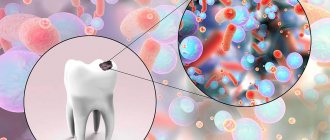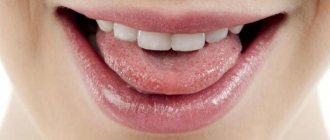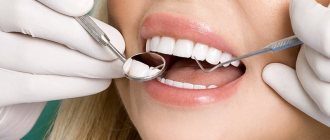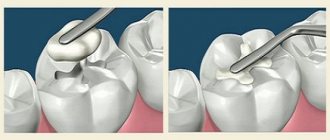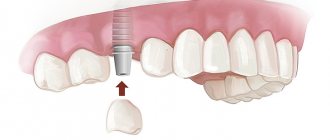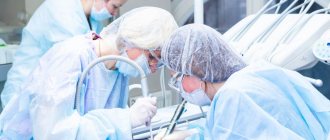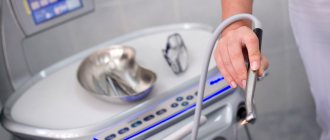Stages of dysbiosis
Depending on the degree of development of the disease, dentists distinguish four stages of dysbiosis:
- Latent. The first, latent stage is characterized by subtle changes in the number of microorganisms of one strain. The patient feels well and does not experience any symptoms of inflammation.
- Subcompensated. The number of lactobacilli decreases, the disease has a blurred picture. The patient may feel discomfort in the oral cavity, but does not always understand that this is dysbacteriosis.
- Pathogenic. Lactobacilli are observed in minimal quantities in the oral cavity. The oral cavity begins to be populated by a facultative pathogenic environment.
- Decompensated. In addition to severe inflammation in the mouth, uncontrolled growth of yeast-like fungi occurs. The functioning of the salivary glands is disrupted, and an unpleasant taste and burning sensation occurs in the mouth.
Advanced forms of dysbiosis are characterized by symptoms such as:
- inflammation of the gums and mucous membranes;
- plaque on the teeth and surface of the tongue;
- bleeding gums;
- ulcers and blisters on mucous membranes;
- increased body temperature;
- swelling and soreness of the tongue;
- dry skin, sticking in the corners of the mouth.
Assessment of the effects of factors affecting the acid-base balance in the oral cavity
It is obvious that the pH of the oral fluid is an indicator that changes under the conditions of the organism’s existence. A method for an integral assessment of factors affecting the acid-base balance in the oral cavity was proposed in 1938 by the American scientist Stefan. Information about the duration, severity of acidotic changes after eating and the speed of their correction can be obtained from the Stefan curve .
Stefan curve
The Stefan curve is a graph of time changes in the pH of oral fluid (microbial plaque) after eating food. At the same time, it is precisely this information that makes it possible to predict the risk of adverse consequences of acid-base imbalances, and, in particular, such as demineralization of enamel. Consider the Stefan curve in oral fluid after eating a piece of sugar. The curve was obtained using repeated measurements of the pH of the oral fluid: before consuming sugar, 15, 30, 45 and 60 minutes after consumption.
It can be seen that within about 15 minutes after taking sugar, the pH drops to minimum values (catacrota). Then the pH rises with the restoration of the original level after an hour from the moment of taking sugar (anacrotic). The drop in pH is due to the production of acids by microflora, the restoration of the original pH value is due to the action of acid-reducing factors in the oral cavity. The assessment of factors that disturb the acid-base balance and factors counter-directed to them is carried out using empirical and calculated indicators.
The clinical significance of the Stefan curve is that it allows one to assess the cariogenic situation in the oral cavity. When the pH decreases below 6.2, saliva is a demineralizing liquid, and when the pH is above 6.2, it is a remineralizing liquid. Therefore, a saliva pH value of 6.2 is called critical. Using the Stefan curve, it is possible to study the cariogenicity (according to acid production) of various food products and the effectiveness of antimicrobial agents (antiseptics, hygiene products).
A number of studies allow us to evaluate individual factors affecting the acid-base balance in the oral cavity. This type of research includes analysis of the number of certain types of acid-producing bacteria in the oral cavity, as well as determination of the buffer capacity of saliva. The buffering capacity of saliva can be determined by the so-called “dipped stick” technique. The technique involves dipping a stick coated with chemical indicators into the patient's mixed saliva. The resulting color is an indicator of the buffer capacity of saliva.
Natural factors affecting the acid-base balance in the oral cavity
Many endo- and exogenous factors influence the acid-base balance in the oral cavity: the general condition of the human body, the severity of conditioned and unconditioned reflexes, muscle (chewing) activity, the nature of breathing, speech, food, oral microflora, hygiene products, dentures, fillings and other. The most pronounced influence in physiological conditions is the vital activity of microflora, the composition of food, the composition and rate of saliva secretion.
Raid
The acid-base balance in the oral cavity depends on the presence of plaque.
Microbial plaque forms mainly on the surfaces of teeth, artificial dentures and on the back of the tongue. Dental plaque (dental plaque) is an accumulation of microorganisms living in the oral cavity on the surface of the teeth with the inclusion of structureless substances of organic nature: proteins, lipids, carbohydrates. Among carbohydrates, dextran is an important homooligosaccharide consisting of glucose residues. Dextran has the ability to adhere (sorb) bacteria to dental plaque. Mature dental plaque in 1g contains about 2.5 • 1011 bacteria.
The main source of energy production from plaque bacteria is the processes of anaerobic breakdown of carbohydrates: lactic acid, butyric acid, propionic acid fermentation. Lactate and other organic acids produced by microbial plaque during the utilization of food carbohydrates are the main “culprits” of acidotic changes not only in the area of dental plaque, but also in the oral fluid. In plaque, there is a process of utilization of urea, which enters the oral cavity mainly with saliva. Bacterial ureases break down urea into ammonia and carbon dioxide. Ammonia, by binding protons, shifts the acid-base balance to the basic side. However, this is not enough to counteract the powerful “metabolic explosion” caused by carbohydrates.
Food
The acid-base balance in the oral cavity depends on food. Food is a destabilizer of acid-base balance. The influence of food should be considered from several aspects.
First, food contains acids and bases. Thus, fruits and juices contain a significant amount of organic acids, which cause a sharp decrease in the pH of the oral fluid (up to 4-3 units). If such a food product does not remain in the mouth for long, this change is short-lived. Longer contact can cause, for example, erosion of hard dental tissues: enamel and dentin. Some foods contain ammonium ions, urea (cheese, nuts, menthol) and are alcogenic. Typically, changes in the reaction of mixed saliva towards the alkaline side are insignificant and do not exceed pH 8.
Secondly, carbohydrates contained in food are metabolized by the microflora of dental plaque, with the formation of large amounts of organic acids, mainly lactate. The most acidogenic are mono- and disaccharides.
In descending order of acidogenicity, they can be arranged as follows: sucrose, invert sugar, glucose, fructose, maltose, galactose, lactose. The particular acidogenicity of sucrose is due to the adaptability of microorganisms to excess sucrose and is explained by its very rapid fermentation in dental plaque, a pronounced stimulating effect on the growth of dental plaque, and a high ability to stimulate the production of polysaccharides in dental plaque, in particular, polysaccharides with adhesive properties.
Thirdly, eating food and chewing it stimulate salivation and, thereby, help level out the resulting pH shifts.
Saliva
The acid-base balance in the oral cavity depends on saliva. Saliva is the main factor in leveling pH shifts in the oral cavity under physiological conditions. Its influence on this indicator is due to:
- mechanical cleaning from food debris; 1
- antimicrobial effect of lysozyme, cyanide anions, phagocytes, immunoglobulins and other components;
- the work of buffer systems: bicarbonate (provides about 80% of the buffer capacity of saliva), protein and phosphate.
The implementation of the pH-stabilizing properties of saliva significantly depends on the rate of its secretion and rheological properties (viscosity). In general, the higher the rate of salivary flow and the lower the viscosity, the greater the ability Muscle contractions associated with chewing, swallowing and speech contribute to the emptying of the salivary glands and the movement of saliva in the oral cavity, and therefore can be considered as a factor in stabilizing the acid-base balance.
Disturbance of oral microflora: causes
Oral dysbiosis can be caused by a variety of diseases and problems. Violation of opportunistic microflora of the oral cavity most often causes problems such as:
- Diseases of the gastrointestinal tract. Malfunctions of the digestive organs lead to a slowdown in metabolic processes in the body. The absorption of vitamins and nutrients deteriorates, the balance of the intestinal bacterial environment is disrupted, which provokes problems in other organs and systems.
- Decreased immunity. If the body's resistance deteriorates, the oral cavity automatically becomes more vulnerable to pathogenic microflora.
- Chronic diseases. Often, small caries or stomatitis, if left untreated, can spread from the source of inflammation to the entire oral cavity.
- Bad habits, such as systematic drinking of alcohol and smoking, inevitably affect the quality of the salivary glands. Prolonged drying out or too much moisture in the oral cavity has a detrimental effect on the composition of the microflora.
- Poor nutrition and lack of vitamins worsens the quality of saliva and makes the microflora of the oral cavity more vulnerable.
- Taking antibiotics and certain medications, such as hormones;
- Wearing dentures.
Methods of artificial influence on the acid-base balance in the oral cavity
The mechanisms of self-regulation of acid-base balance do not always work effectively enough. Therefore, various ways of influencing the main elements of regulation are used.
The most effective way is to influence the oral microflora and its metabolic activity. This influence can be carried out in several ways:
- mechanical removal using hygiene products (flossing and tongue cleaning, teeth brushing);
- use of antiseptics, fluorides;
- limiting the intake of easily metabolized carbohydrates into the oral cavity
Another way of influencing the acid-base balance in the oral cavity is by influencing the oral fluid, for example, increasing the rate of salivation. Increased salivation is promoted by tougher foods (due to muscle activity), chewing gum, and adding small amounts of acids to food, such as citric acid.
An increase in the rate of salivation leads to an acceleration of the mechanical cleansing of the teeth and oral cavity from food carbohydrate residues, deflated epithelium, and there is an increased entry into the oral cavity of new molecules of buffer systems and antimicrobial components of saliva.
